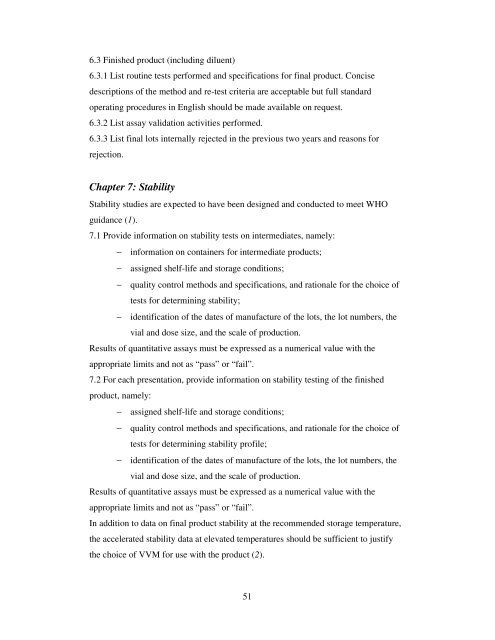Procedure for assessing the acceptability, in principle, of vaccines ...
Procedure for assessing the acceptability, in principle, of vaccines ...
Procedure for assessing the acceptability, in principle, of vaccines ...
Create successful ePaper yourself
Turn your PDF publications into a flip-book with our unique Google optimized e-Paper software.
6.3 F<strong>in</strong>ished product (<strong>in</strong>clud<strong>in</strong>g diluent)<br />
6.3.1 List rout<strong>in</strong>e tests per<strong>for</strong>med and specifications <strong>for</strong> f<strong>in</strong>al product. Concise<br />
descriptions <strong>of</strong> <strong>the</strong> method and re-test criteria are acceptable but full standard<br />
operat<strong>in</strong>g procedures <strong>in</strong> English should be made available on request.<br />
6.3.2 List assay validation activities per<strong>for</strong>med.<br />
6.3.3 List f<strong>in</strong>al lots <strong>in</strong>ternally rejected <strong>in</strong> <strong>the</strong> previous two years and reasons <strong>for</strong><br />
rejection.<br />
Chapter 7: Stability<br />
Stability studies are expected to have been designed and conducted to meet WHO<br />
guidance (1).<br />
7.1 Provide <strong>in</strong><strong>for</strong>mation on stability tests on <strong>in</strong>termediates, namely:<br />
− <strong>in</strong><strong>for</strong>mation on conta<strong>in</strong>ers <strong>for</strong> <strong>in</strong>termediate products;<br />
− assigned shelf-life and storage conditions;<br />
− quality control methods and specifications, and rationale <strong>for</strong> <strong>the</strong> choice <strong>of</strong><br />
tests <strong>for</strong> determ<strong>in</strong><strong>in</strong>g stability;<br />
− identification <strong>of</strong> <strong>the</strong> dates <strong>of</strong> manufacture <strong>of</strong> <strong>the</strong> lots, <strong>the</strong> lot numbers, <strong>the</strong><br />
vial and dose size, and <strong>the</strong> scale <strong>of</strong> production.<br />
Results <strong>of</strong> quantitative assays must be expressed as a numerical value with <strong>the</strong><br />
appropriate limits and not as “pass” or “fail”.<br />
7.2 For each presentation, provide <strong>in</strong><strong>for</strong>mation on stability test<strong>in</strong>g <strong>of</strong> <strong>the</strong> f<strong>in</strong>ished<br />
product, namely:<br />
− assigned shelf-life and storage conditions;<br />
− quality control methods and specifications, and rationale <strong>for</strong> <strong>the</strong> choice <strong>of</strong><br />
tests <strong>for</strong> determ<strong>in</strong><strong>in</strong>g stability pr<strong>of</strong>ile;<br />
− identification <strong>of</strong> <strong>the</strong> dates <strong>of</strong> manufacture <strong>of</strong> <strong>the</strong> lots, <strong>the</strong> lot numbers, <strong>the</strong><br />
vial and dose size, and <strong>the</strong> scale <strong>of</strong> production.<br />
Results <strong>of</strong> quantitative assays must be expressed as a numerical value with <strong>the</strong><br />
appropriate limits and not as “pass” or “fail”.<br />
In addition to data on f<strong>in</strong>al product stability at <strong>the</strong> recommended storage temperature,<br />
<strong>the</strong> accelerated stability data at elevated temperatures should be sufficient to justify<br />
<strong>the</strong> choice <strong>of</strong> VVM <strong>for</strong> use with <strong>the</strong> product (2).<br />
51

















